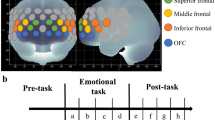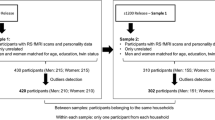Abstract
To investigate the neuro-biological bases of introversion-extraversion personality traits, the concentration of four neurochemicals (Cho, ml, α-Glx and NAA) in anterior cigulate gyrus between normal extroverts and introverts were examined using non-invasive1H MRS technique. Our study revealed that introverts have significantly higher level of α-Glx, Cho and mI in the anterior cingulate gyrus than extroverts. This result provides new evidence that the anterior cingulate gyrus is related to personality traits partly in support of Eysenck’s supposition that introverts have higher arousal level than extroverts. Moreover, this result offers neurochemical data for psychobiological theories of personality.
Similar content being viewed by others
References
Zuckerman, M., Kuhlman, D. M., Joirman, J. et al., A comparison of three structural models for personality: The big three, the big five, and the alternative five, J. Personality Sociol Psychol., 1993, 65: 757–768.
Zukerman, M., What is a basic factor and which factors are basic? Turtles all the way down, Personality Individual Diff., 1992, 13: 675–681.
Gao, Y. X., Personality Psychology, 2nd (in Chinese), Beijing: Beijing Normal University Press, 2002, 183–327.
Eysenck, H. J., The Biological Basis of Personality, Springfield. III: Thomas, 1967.
Mathew, R. J., Weinman, M. L., Barr, D. L., Personality and regional cerebral blood flow, Br. J. Psychiatry, 1984, 144: 529–532.
Canli, T., Zhao, Z., Desmond, J. E. et al., An fMRI study of personality influences on brain reactivity to emotional stimuli, Behav. Neurosci., 2001, 115(1): 33–42.
Jesus, P., Anna, L., Joan, D. et al., Anatomical variability of the anterior cingulate gyrus and basic dimensions of human personality, NeuroImage, 2002, 15: 847–855.
Christian, G., Bernet, M., Eric, V. et al., Neural correlates of memories of abandonment in women with and without borderline personality disorder, Biol. Psychiatry, 2003, 54: 142–151.
Zenab, A., Todd, C., Turhan, C., Attentional bias for valenced stimuli as a function of personality in the dot-probe task, J. Res. Personality, 2004, 38: 15–23.
Debra, L., John, S., Sherri, M. et al., Cerebral blood flow and personality: A positron emission tomography study, Am. J. Psychiatry, 1999, 156: 252–257.
Zuckerman, M., Psychobiological theories of personality, in Advanced Personality (eds. Barone, D. F., Hersen, M., Van Hasselt, V. B.), New York: Plenum Press, 1994.
Yousha, M., Jennifer, T., Aileen, R. et al., Reduced anterior cingulate cortex glutamatergic concentrations in childhood major depression, J. Am. Acad. Child Adolescent Psychiatry, 2004, 43(3): 341.
Zhang, H. C., Xu, J. P., Modern Psychological and Educational Statistics (in Chinese), Beijing: Beijing Normal University Press, 2003, 379–383.
Ludger, T., Bernd, H., Thorsten, T. et al., Frontolimbic brain abnormalities in patients with borderline personality disorder: A volumetric magnetic resonance imaging study, Biol. Psychiatry, 2003, 54: 163–171.
Tang, Z. L., Pan, J. C., Wu, Z. R. et al., Neurobiology (in Chinese), Shanghai: Fudan Press, 1991.
Dorothee, P. A., Benno, P., Eduard, K. et al., Reduced glutamate in the anterior cingulate cortex in depression: Anin vivo proton magnetic resonance spectroscopy study, Biol. Psychiatry, 2000, 47(4): 305–313.
Javier, G., Olga, S., Yolanda, A. et al., Choline determination based on the intrinsic and the extrinsic (chemically modified) fluorescence of choline oxidase, Analytical Biochemistry, 2004, 334: 207–215.
Jin, Z., Zang, Y. F., Zeng, Y. W. et al., Striatal neuronal loss or dysfunction and choline rise in children with attention-deficit hyperactivity disorder: A−1H-magnetic resonance spectroscop study, Neurosci. Lett., 2001, 315: 45–48.
Renshaw, P. F., Lafer, B., Babb, S. M. et al., Basal ganglia choline levels in depression and response to fluoxetine treatment: Anin vivo proton magnetic resonance spectroscopy study, Biol. Psychiatry, 1997, 41: 837–843.
Michell, R. H., The multiplying roles of inositol lipids and phosphates in cell control processes, Ess. Biochem., 1997, 32: 31–47.
Pablo, D., Albert, T., Kenneth, Y. et al., Decreased anterior cingulate myo-inositol/creatine spectroscopy resonance with lithium treatment in children with bipolar disorder, Neuropsychopharmacology, 2001, 24(4): 359–369.
Nick, J. C., Catherine, J. O., Kathleen, M. H. et al., Decreased prefrontal myo-inositol in major depressive disorder, Biol. Psychiatry, 2005, 57: 1526–1534.
Constance, M., Janis, L., Thellea, J. et al., Effects of myo-inositol ingestion on human brain myo-inositol levels: A proton magnetic resonance spectroscopic imaging study, Biol. Psychiatry, 1999, 45: 1197–1202.
Guan, X. M., Han, J. S., Medicinal Neurobiology (in Chinese), Beijing: People’s Medical Publishing House, 2002, 582–584.
Hesslinger, B., Thiel, T., Tebartz, V. E., Attention-deficit disorder in adults with or without hyperactivity: Where is the difference? A study in humans using short echo1−H-magnetic resonance spectroscopy, Neurosci. Lett., 2001, 304: 117–119.
Chen, Z. G., Zhang, Y. X., Personality Psychology (in Chinese), Liaoning: Liaoning People Press, 1986, 143–145.
Cloninger, R., Svrakic, D., Przybeck, T., A psy-chobiological model of temperament and character, Arch. Gen. Psychiatry, 1993, 50: 975–990.
Soyka, M., Preuss, U., Koller, G. et al., Dopamine D 4 receptor gene polymorphism and extraversion revisited: Results from the Munich gene bank project for alcoholism, J. Psychiatric Research, 2002, 36: 429–435.
Michel, H., Emmanuel, P., William, P. et al., Further evidence on the relationship between dopamine and novelty seeking: A neuroendocrine study, Personality Individual Diff., 2002, 33: 967–977.
Srinivasan, R., Vigneron, D., Sailasuta, N. et al., A comparative study of myo-inositol quantification using LCmodel at 1.5 T and 3.0 T with 3D1− H proton spectroscopic imaging of the human brain, Magn. Reson. Imaging, 2004, 22: 523–528.
Author information
Authors and Affiliations
Corresponding author
About this article
Cite this article
Xu, S., Peng, D., Jin, Z. et al. Personality and neurochemicals in the human brain: A preliminary study using1H MRS. Chin.Sci.Bull. 50, 2318–2322 (2005). https://doi.org/10.1007/BF03183742
Received:
Accepted:
Issue Date:
DOI: https://doi.org/10.1007/BF03183742




